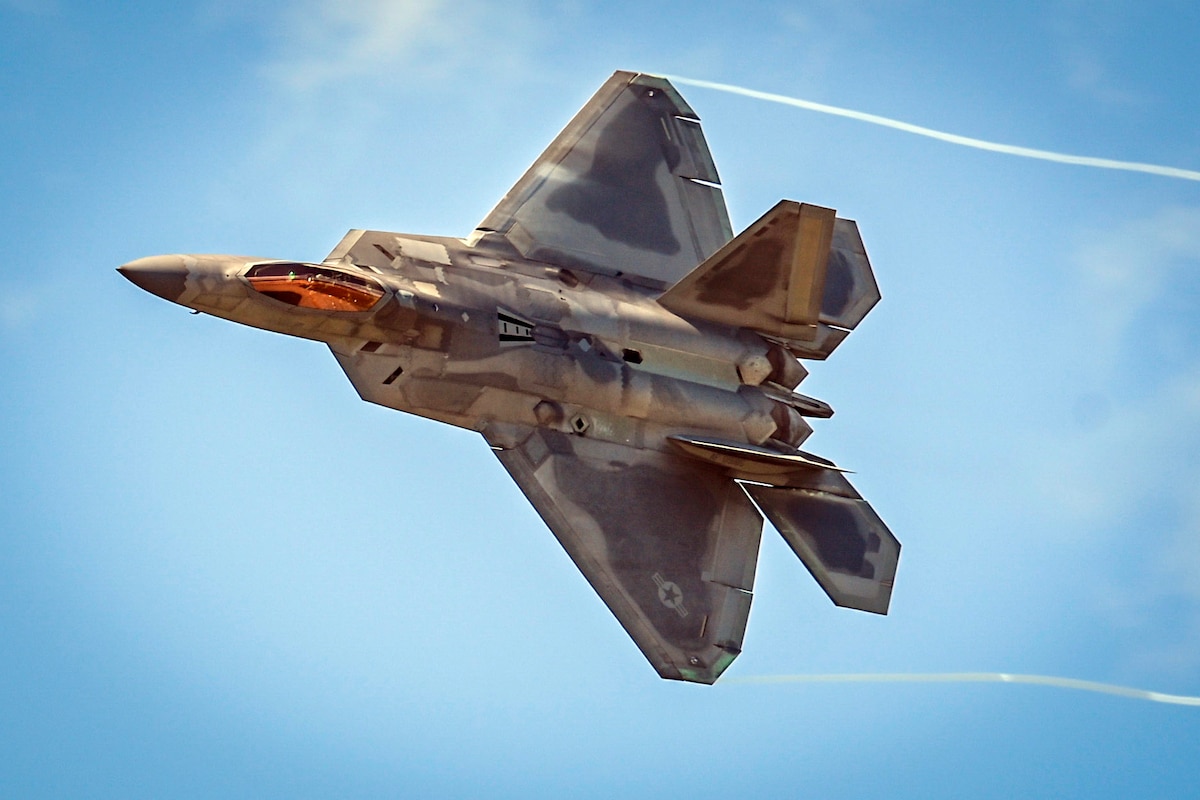The F-22 Raptor, arguably the world’s best stealth fighter aircraft, teamed up with a loyal wingman-type drone in a “first of its kind” demonstration.
The F-22 Raptor is at the forefront of the US Air Force’s planned integration of CCA (Collaborative Combat Aircraft) with stealth fighter jets in a manned-unmanned teaming (MUMT) configuration. In line with that, a pilot flying the Raptor successfully commanded an MQ-20 Avenger drone from the jet’s cockpit.
The demonstration took place on October 21, 2025, over the USAF’s sprawling Nevada Test and Training Range (NTTR). It was conducted by General Atomics in partnership with Lockheed Martin, the manufacturer of the F-22 Raptor, and L3Harris, which provided radio and datalink.
“The effort integrated L3Harris’ BANSHEE™ Advanced Tactical Datalinks with its Pantera software-defined radios (SDRs) via Lockheed Martin’s open radio architectures, all integrated and shared from an F-22 Raptor,” General Atomics said.
The demonstration was backed by two L3Harris Software-Defined Radios (SDRs). The General Atomics MQ-20 Avenger had the first SDR installed, while the single-seat F-22 Raptor had the second.
The technology enabled end-to-end communications through the Pilot Vehicle Interface (PVI) tablet and the F-22’s GRACE module, allowing the F-22 to command and control the MQ-20 while in flight.
Software-defined radios (SDRs) are radio communication systems that offer flexibility and adaptability by using software in place of conventional analog hardware to carry out tasks like signal processing.
Meanwhile, GRACE here refers to the Government Reference Architecture Compute Environment. The purpose of this open-architecture systems module for the F-22 is to facilitate the integration of new software packages onto the aircraft, such as those supporting the function of an airborne drone controller.
Recent GA-ASI flight test demos crewed-uncrewed teaming with F-22 Raptor and MQ-20 #AvengerUAS.
Read the news: https://t.co/L1KHkx6P6U#UCAV #DubaiAirshow #DAS25 pic.twitter.com/cgBlzNNKjI
— General Atomics Aeronautical Systems, Inc (GA-ASI) (@GenAtomics_ASI) November 17, 2025
The press release highlighted that the joint demonstration showcased non-proprietary, US government-owned communications capabilities and flying hardware that is essential to the Open Mission Systems and skills-based unmanned autonomy ecosystem, including the capability to fly, transition, and re-fly.
Notably, the development comes months after the USAF Long Term Fighter Force Structure report noted that the upcoming CCA or loyal wingman drones will be paired with F-22s and F-35s, with the F-22 serving as the “threshold platform” for drone integration.
This is significant given that the Raptors were earlier expected to be phased out in favour of the Next-Generation Air Dominance (NGAD) fighter, but are now expected to remain operational well into the 2040s alongside the next-generation F-47 developed by Boeing.

The 2026 Fiscal Year budget proposals from earlier this year included an all-new line item for CCA-related modifications to aircraft.
The budget reportedly proposed US$15 million for the Crewed Platform Integration program. And, of the US$15 million, nearly US$12.2 million was earmarked for the procurement of 142 tablets and associated cabling.
“The Crewed Platform Integration program will procure and integrate kits for F-22 installation, which will allow for F-22 control of Collaborative Combat Aircraft (CCA),” the Air Force’s proposed Fiscal Year 2026 budget stated.
Besides the F-22 and the F-35, the F-47 will also naturally operate in manned-unmanned teaming with CCA. Moreover, plans to include the F-15EX and the F-16 into the mix are also being considered.
General Atomics stated that the demonstration was part of an ongoing series of flight tests performed using internal research and development funding to showcase “the art of the possible” between manned and unmanned teaming.

As of now, General Atomics and Anduril are developing drones, designated the YFQ-42A and YFQ-44A, respectively, for Increment 1 of the CCA program.
The maiden flight of the General Atomics YFQ-42A fighter drone was announced in August 2025 to assess the platform’s airworthiness, flight autonomy, and mission system integration. Meanwhile, Anduril’s drone prototype is also expected to start flight testing soon.
While both drones are still under development, General Atomics is leading the way with real-time testing with the F-22 Raptor to stay ahead of its rival. The MQ-20 has been used as a testbed in other experiments.
“The MQ-20 Avenger, tricked out with mature mission autonomy software, is a perfect CCA surrogate and allows us to move fast and move first,” GA spokesman C. Mark Brinkley told Breaking Defense. “We already know the F-22 will play a critical role in crewed-uncrewed teaming operations, and General Atomics is in a unique position to get this started now.”
CCA Integration Catches Pace
The US Air Force’s Collaborative Combat Aircraft (CCA) program was launched in March 2023 by the former Secretary of the USAF, Frank Kendall. It focuses on developing semi-autonomous drones, often called “loyal wingmen,” that operate alongside manned fighter jets in a teaming configuration to enhance air superiority.
These drones are meant to provide additional combat effects, supporting crewed aircraft by carrying extra air-to-air munitions, extending sensor coverage, and executing missions that could likely put human pilots at risk.
Previous reports indicated that these CCAs will primarily serve as airborne “missile trucks” in their initial deployment, flying in formation with crewed jets to provide additional firepower. However, discussions are ongoing about expanding their roles to include electronic warfare, intelligence gathering, surveillance, reconnaissance, and even fully autonomous missions.
The Pentagon has ambitious plans to mass-produce these CCAs at a significantly lower cost compared to conventional fighter jets. For instance, an F-35 Lightning II aircraft can cost anywhere from US$80 million to US$115 million, depending on the type, whereas the projected cost of the CCA drones that the USAF is building is between US$25 million and US$35 million each.
The idea is that deploying cheap, attritable drones as companions to expensive, manned fighters would enhance mission success while improving the survivability of the manned platform, especially when engaging a near-peer adversary in contested environments. China has a highly sophisticated Anti-Access/Area Denial (A2/AD) system along its coastline, likely making manned operations very difficult in a conflict.
Manned-Unmanned Teaming (MUM-T) will outperform opponents by delivering larger, faster, and less expensive impacts. These inexpensive drones have the potential to be deployed as decoy formations, designate targets for laser weapons, enhance targeting by ground-based weapons and aerial platforms, carry armaments for precision strikes, and jam enemy defenses.
The information regarding the precise number of CCAs the Air Force intends to purchase and over what time frame is currently classified.
According to previous statements made by Air Force officials, about 100 to 150 drones will be ordered under the Increment 1 phase, with hundreds more anticipated via subsequent incremental development cycles. Nonetheless, it is currently unclear if the service intends to downselect one design or buy multiple loyal wingman drones.
Earlier, Frank Kendall said that the USAF is working to acquire what could ultimately be a fleet of multiple different types of CCA drones through iterative development cycles.
The USAF was also known to be refining plans for Increment 2 of the CCA program, which will introduce a new generation of drones with enhanced capabilities. These next-generation CCAs are expected to be more advanced, but also more expensive; however, their exact mission profiles and technological enhancements have yet to be determined.
Notably, the loyal-wingman drones are the next big thing in air combat, and several countries are working on technology that can revolutionize the field.
For instance, China is also developing loyal wingman drones designed to operate alongside stealth fighters like the J-20. In fact, the country has now unveiled a twin-seater J-20S stealth aircraft, which could ease the integration by assigning the drone control to the second pilot.
Similarly, the French Air and Space Force also announced the development of a stealthy uncrewed aerial vehicle (UCAV) that will fly alongside the futuristic ‘Super Rafale’ in a manned-unmanned teaming configuration.
Australia, on the other hand, is developing the Boeing MQ-28A Ghost Bat in collaboration with the Royal Australian Air Force (RAAF). This stealthy, multirole UCAV is set to conduct its first live-fire test and enter service soon. In fact, Boeing is pitching the combination of F-15EX and MQ-28A to Poland.
Meanwhile, the Indian Navy is collaborating with NewSpace Research & Technologies on the Naval Collaborative Combat Air Vehicle (N-CCAV), named Abhimanyu, to operate with MiG and Rafale-M jets. Separately, India’s Hindustan Aeronautics Limited (HAL) is developing the CATS Warrior drone for the Combat Air Teaming System (CATS).
It must be noted that this is an incomplete list of CCA efforts, with several other countries pursuing similar projects with an eye on enhancing survivability in future aerial combat.
With rival drones under development and testing and a production decision on the horizon, the US CCA program is poised to deliver Initial Operational Capability (IOC) by 2029, revolutionizing air dominance through affordable, AI-enabled teaming. General Atomics, for one, seems to be in overdrive to emerge as the winner.
- Contact the author at sakshi.tiwari13 (at) outlook.com
- Follow EurAsian Times on Google News




